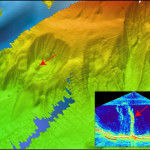
Going on as we speak is an experiment of monumental proportions. It may not seem that way to you sitting in front of your computer this moment, but to a kid in middle or high school I guarantee that it is their world! At least the highlight of their school day anyways…
As part of the GLOBE program funded by NASA, NSF and the U.S. Dept. of State, the Pennsylvania State University. in cooperation with scientists from the RIDGE and InterRIDGE communities, is leading the way for students to explore science From Local to Extreme Environments (FLEXE). “FLEXE students study aspects of their local environment and compare these to deep-sea hydrothermal vents and cold seeps,” explains Liz Goehring, the education and outreach coordinator for RIDGE 2000, “In this first year pilot study, students are measuring and understanding temperature patterns in their local region and comparing these to temperature patterns and processes in the deep-sea. Seeing similarities and differences should lead them to a deeper understanding of earth system processes.”

Map from the OSC Expedition website, Bathymetry of the 9°03’N area of the EPR, after Kent et al. (2000).
At sea right now is a group of earth scientists investigating an Overlapping Spreading Center at 9N on the East Pacific Rise (EPR). “An overlapping spreading center is feature, best observed along fast-spreading ocean ridges, where the ridge axis, normally a relatively continuous feature for long distances, splits into two distinct segments, that are offset from one another and overlap for several kilometers,” describes OSC expedition chief scientist Emily Klein, Lee Hill Snowdon Professor of Geology at Duke University. This cruise is ongoing and you can follow their progress online with daily dispatches from high school teacher and expedition participant Laura Preston. Klein further elaborates that “Our primary goal is to understand the relationships between, on the one hand, the known distribution of melt in magma chambers at depth beneath the two limbs of the overlapping spreading center, and, on the other, the geological and geochemical character of the ridge on the surface.” Goehring adds that the FLEXE program is “sailing with this science party to test the FLEXE Forum (see below) and develop ideas for future comparative learning activities and data-based protocols.” The data that scientists are gathering will be compared to data gathered by middle and high school students around their own local environment. Additionally, there are web-based interactions with the scientists, as well as other classmates and partner school students, that help the students to understand patterns in the data, identify underlying mechanisms, understand the linkages between different components of earth systems and see first-hand how science is done and hypotheses are tested. “Students analyze deep-sea datasets, respond to questions about the data, and then receive feedback from scientists about their ideas. The ‘dialog’ is facilitated by educators sailing with the science party,” says Goehring. “The specific questions students in the pilot are investigating have to do with understanding the transfer of energy between components of the earth system, a central concept in national science education standards.” The internet is the tool connecting students with scientists at sea through a website where students and scientists upload their data. “Students in the classroom lose sight of authentic science being accomplished everyday in the ‘real’ world. Science becomes more meaningful when they get to communicate with scientists ‘on the job’,” states Laura Preston, a Salem High School teacher from New Hampshire. She continues that “Our students can relate their situation to that of the researchers, making a more effective classroom experience.” Klein adds that “As a female scientist and Chief Scientist on this cruise, I would also note that the graduate student group out with us is more than half female, and I feel it is particularly valuable to [students] to see women in scientific leadership roles.” You can get more information about FLEXE through the Penn State Portal: http://flexe.psu.edu The 9 North OCS Expedition is live through April 27th, follow their expedition through a website set up at Duke University: http://www.nicholas.duke.edu/OSCexpedition/
Share the post "From The Desk of Zelnio: Scientists & Students FLEXE Their Scientific Muscles!"





